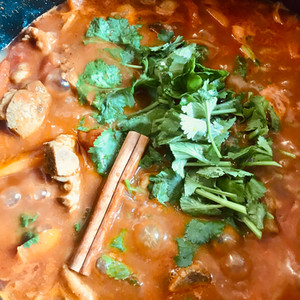Chennai lamb and coconut curry
- Hobbychef
- Jun 20, 2023
- 7 min read
Updated: Jun 21, 2023
This delicious lamb dish may take its name from the state capital of Tamil Nadu, but Chennai lamb and coconut curry is far more South African than Indian in the final analysis.

A misnomer is ever there was one, yes, it's likely this dish has its origins in southeastern India, in the state of Tamil Nadu. But, no, it's unlikely to have originated in the state capital Chennai for which it is colloquially named, perhaps to differentiate it from the numerous other lamb "curry" dishes in the South African cuisine of the Indian diaspora. Chances are it originated in the coastal regions further south from which many immigrants travelled to South Africa to work in Natal's sugar cane fields in the late 19th and early 20th centuries. Historical nitpicking aside, it remains a delicious dish of medium-to-hot spiciness—though you can crank up the fire if you wish.
This is another dish my father loved to cook. I have no idea where he chanced upon the recipe. But, I suspect it was somewhere along KwaZulu-Natal's coast north of Durban, a regular "hunting ground" for obscure ingredients, old Indian ladies with many cooking secrets and interesting dishes.
This dish feeds 2 to 3 diners. NB: at these quantities, the curry paste actually produces a medium-to-hot curry. I tend to ramp up the number of red chillies if I'm cooking it for myself. But, cook it at these spice quantities when catering for those who don't like things too spicy. Two of the condiments make it milder for the spice-timid.
On the lamb
My favourite lamb for this dish is what gets called "lamb trim" in the UK. It's usually a mix of shoulder, leg and anything in between; the bits butchers literally trim away when cutting those sought after expensive cuts. Traditionally considered "poor meat", it may contain bone, fat or be surprisingly lean: there is no "rule". It's not easy to find. If you can, I thoroughly recommended it. Yes, of course you can use cubed, lean lamb, but there is something about lamb trim congruent with this dish's DNA, born of necessity—not to mention that the fatty bits and shards of bone actually deepen the flavour.
Another "slow-low dish". Apart from when it needs to cook on a high heat in the first stage of the cooking, this is one that comes into its own when you've got time to slow-cook. Just set your timer and check on it at relevant intervals while you're getting on with something else. Do it right, and it produces that kind of melt-in-the-mouth consistency. Another dish that is far less about skill and more about patience; a genuinely easy-to-cook dish.
Shopping list
The curry paste
I almost never make my own curry paste for this dish any longer. I make it too infrequently to whip up a homemade spice paste in the quantities I do for other curries I cook more often. Rather I use a combination of Madras curry powder, such as this one by Natco and Madras spice paste, such as this one by Patak
I tend to use these in combination with a few other fresh or "unprocessed" ingredients—such as fresh coriander and cinnamon sticks.
For the Chennai lamb and coconut curry
3 tbspn peanut oil (or sunflower oil)
2 tspn garlic & ginger paste
1 tspn turmeric
1 tbspn Madras curry powder
A 400g tin of chopped tomatoes in their juice (preferably not plum tomatoes)
1 large red sweet chilli; deseeded and sliced
2 brown onions, sliced—cut in half then sliced vertically to produce "strips"
Approx. 400g lamb; (if it's "trim" with bone attached, cook with the bone on)
1 red bell pepper, cut into vertical slices
1 vegetable stock cube/jelly (see note below in "alternatives") diluted in approx. 200ml boiling water
2 tbspns Madras spice paste
120ml coconut milk
A generous clutch of fresh coriander; de-stalked and roughly chopped
1 stick (approx. 5cm) of cinnamon
salt and freshly ground black pepper
For the condiments
2 small hot green chillies, finely chopped
2 small hot red chillies, finely chopped
1 large shallot, finely cubed
3 or 4 cherry tomatoes; finely cubed
A little vinegar
1 banana, sliced
2 tbspns desiccated coconut
A little full-fat milk
Approx. 100ml natural yoghurt
Approx. 6cm of a cucumber, finely cubed or grated
A small clutch of fresh coriander, finely chopped
Cooking Method
For the Chennai lamb curry
Heat the oil in a sizeable pot with a lid on a fairly high heat. When the oil is hot, sprinkle in the Madras curry powder and allow to sizzle for no more than a minute, stirring to prevent sticking. Almost immediately, add the lamb and stir regularly so that it seals on all sides. It's likely to ooze a certain amount of fat
Once the lamb is sealed, remove from the pot using a slatted or "sieve" spoon. Place in a dish lined with kitchen towel or onto a mesh basket over a bowl so that it can drain. Do not remove the lamb fats from the pot
Return the pot to the heat. When hot once again, add the garlic and ginger paste, allowing it to sizzle, stirring to prevent sticking. When it starts turning golden, add the onions, followed a minute or so later by the sliced red chilli. Cook these together until the onion starts to soften. Add the turmeric at the same time, also adding the red bell pepper. Cover and allow to sweat. If the ingredients show signs of sticking, add a little water—a few tbspns at a time—and sweat with the lid on until the ingredients soften
Once the onions and bell peppers become soft, add the Madras spice paste and stir vigorously. Add the lamb back into the pot after a minute or so, stirring until it's coated with the spice paste. If it sticks or becomes too dry, add a little water, a couple of tbspns at a time. Cover and sweat the ingredients together for 3 or 4mins
Add the chopped tomatoes. Stir in and bring to a vigorous simmer. Season with salt and black pepper. Dilute the stock in the tomato can and pour in. Stir and increase the heat to a vigorous boil. Cover and boil for approx. 5mins. Stir to prevent sticking
Uncover, add the coriander and cinnamon stick to the top of the mix. Re-cover without stirring. Reduce to a low heat. Simmer to at least 20mins before stirring. Stir and reduce to a heat to where the contents are barely simmering. Simmer on a very low heat for at least 90mins, stirring approx. every 20mins
Once the ingredients have cooked for 90mins, add the coconut milk and stir in. If necessary, slightly increase the heat to bring it back to a minimal simmer. Stir in the coconut milk once the ingredients have been simmering for 10mins
Stir and reduce the heat to a minimum. Cook on this very low heat for a further 30mins or so, stirring occasionally
When you've prepared all the condiments and side dishes, turn off the heat. Cover and keep warm until plating
Side Dishes
Basmati rice—particularly "Durban yellow rice" (cooked with turmeric)—is probably the most common accompaniment with this dish. Alternatively serve with naan breads or chapati.
Condiments
Almost all South African "Indian" food is served with raw sambals and condiments. In this case there are three, all Indonesian in origin. They're generally prepared just prior to serving and presented at table in condiment dishes:
"sambal" — finely chopped tomatoes, shallots and fiery chilli peppers mixed with vinegar. These add heat for those who like it
"piesang met klapper" — sliced banana and desiccated coconut. Ordinarily the banana is prevented from going brown with a "bath" of full-fat milk. (If vegan, use lemon juice or coconut milk). For those who don't like spice; need it calmed down
"raitha" — an Indian classic, this combination of natural yoghurt, chopped cucumber and fresh coriander is another means of "calming down" this (supposedly) spicy curry

Alternatives
Vegans and vegetarians
To date, the veggie and vegan "answers" I have are Quorn, soya pieces or potatoes. I have also created a lovely version with big chunks of "Zulu pumpkin" (flat white boer pumpkin—I kid you not) added only when the coconut milk is added in the recipe above.
Pescatarians
So far, the versions I've really liked are squid or wild shrimp—which you only add in roughly the last ten minutes of the cooking time. I tried a version with tuna steaks, but it was grim.
Other
Stock —traditionally this recipe uses beef stock versus vegetable stock. Don't pooh-pooh it: it affords a deep and curious taste, one that I tend to prefer in colder months. However, in warmer weather, vegetable stock somehow works better
Spiciness—technically this is a medium-to-hot spicy dish. Personally, I think it's pretty mild—hence the sambal that can crank it up. Alternatives are a) more chillies at the outset; b) do not seed the chillies and cook them with the seeds
Pairings
I think this dish works really well with a good South African Pinotage. My personal favourite remain the glorious range of Pinotage wines from Simonsig winery. More recently I've really enjoyed it with this Kanonkop Kadettee Pinotage.
That said, over the years, I've really enjoyed this dish with various medium bodied wines, most notably Pinot Noirs, Carménères, Barberas and even the odd Côtes du Rhône on the lighter end of the scale. There is an undeniable "fattiness" to this dish, the result of both the lamb and the coconut. For me, medium bodied wines act as the best "detergent", providing the best palate counterpoint; strong enough to absorb the intense flavours, light enough to not induce a stupor—the case with much heavier red wines. But, of course, we default to Karel for us to live and learn. We'll dial back once his one-man jury is in.
Of course, curry and beer is a marriage born in heaven. Sadly, I have little direct comparative experience in this case apart from memories of this dish enjoyed with ice-cold lashings of Castle Lager, the seminal South African lager on nights almost as hot as the curry and quaffable beer so cold it cooled the soul. And today I'm trying it for the first time with an American-style IPA (Indian Pale Ale).
Nobody's shot the dog or stolen my truck yet.









Comments